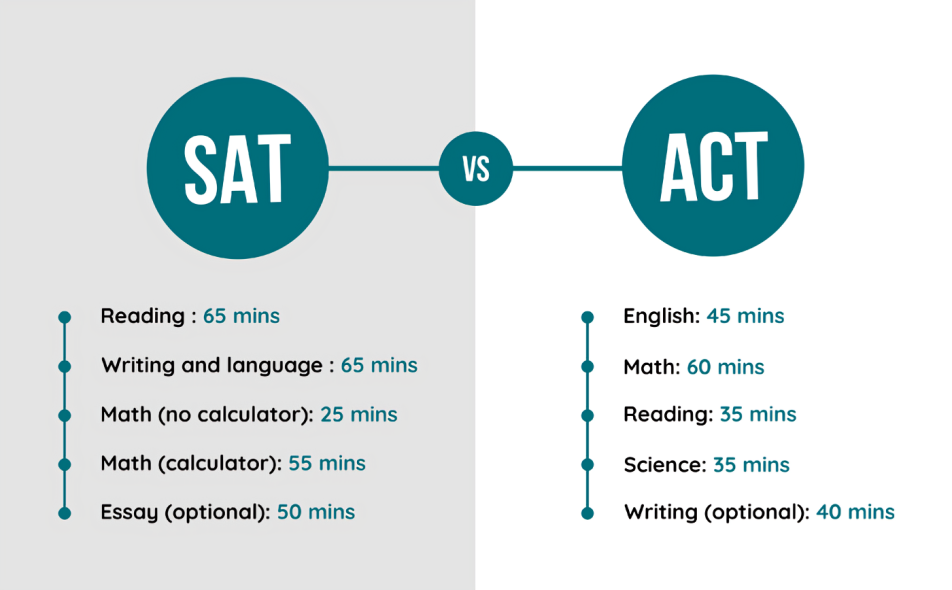As high school students look toward the application process, one of the most important components is their standardized test scores. Following the COVID-19 pandemic, colleges have begun reinstating the standardized test requirement. Standardized testing in the United States has undergone major alterations. In March 2024, the digital SAT was released, fully replacing the paper version. Similarly, the ACT has launched a digital version, though it will not completely supersede the paper version. Both standardized tests have implemented major changes in format and content. This comprehensive guide will help students determine whether the new SAT or ACT is best for them.
SAT: The SAT has undergone numerous changes. The most important change is that the overall testing time has decreased from three hours to two hours. This change makes the SAT less stamina-based and generally less stressful. One Belmont Hill student who took the SAT said, “It was definitely not as stressful as I imagined, and it felt short too.” During the pilot testing in November 2021, 80% of students found the new format to be significantly less stressful than the paper version. A large difference between the new SAT is that the SAT adjusts the difficulty of the second half of the test based on the test-taker’s performance, unlike the ACT. Thus, the SAT is tailored to each student and provides a more precise assessment of the student’s abilities. In addition, the SAT has higher difficulty and complexity per question, but has fewer questions compared to the ACT. Therefore, even though a question may be more difficult, students have more time to answer it.
The SAT gives test-takers 41%-44% more time per question than the ACT. For instance, the math section includes a portion of Free Response Questions rather than being a total multiple-choice test. Another major difference between the tests is their content. The SAT consists of two sections: Reading and Writing and Math, with questions on earth science, biology, chemistry, and physics integrated throughout. The math section also contains an in-test sheet for various geometric and algebraic formulas. As a result, test-takers do not have to memorize formulas before the test. Instead, they are encouraged to learn how to understand and apply the relevant topics. The SAT also contains much shorter passages, each accompanied by a single question. Overall, the SAT allows for a less stressful test compared to previous years and provides a more accurate assessment of students’ abilities. On the other hand, it is much more challenging and requires the application of concepts rather than just knowing them.
ACT: While the SAT focuses more on deductive reasoning and problem-solving through tricky and complex questions, the ACT takes a more direct approach to test-taking. The ACT is the better test, as it rewards and challenges mental clarity, quick thinking, and practical knowledge; all skills that are imperative for a student. The ACT is a longer test in terms of time and the number of questions, but as a result, those questions are a lot less complex as compared to the SAT, requiring students to be able to think quickly and logically, instead of wasting their time analyzing the same documents over and over again like the SAT does.
When asked, a group of students explained that the ACT’s English and reading questions are significantly easier and much more straightforward than the SAT, focusing predominantly on grammar and quick sentence structure, which allows students with strong background knowledge to succeed. Additionally, the math section varies throughout topics, covering algebra 1 and 2, geometry, trigonometry, and precalculus, further helping students with strong quantitative skills and a wide range of knowledge, unlike the SAT, which tends to emphasize word-heavy algebra problems. The ACT also features a science section, a unique aspect that no other standardized test offers. While the science is not direct scientific knowledge, it challenges the students’ ability to analyze data, interpret graphs and draw conclusions from experiments, all being key skills required for anyone interested in pursuing a career in science, and if a student wants to take the ACT but is not confident in science, it is completely optional to both submit and even take the section. Finally, a 35 or 36 on the ACT is much easier to obtain than a 1550 on the SAT, and they both look similar to colleges. Unfortunately, for students with learning disabilities, it is significantly harder to get accommodations for the ACT, and many say that the stress of running out of time is worse than the difficulty of the SAT problems.
While it seems challenging to figure out which test to take on top of having to study and prepare for them, it turns out that there are ups and downs to each test. For those who have less difficulty reading and digesting more complex information, and who tend to lean towards the humanities, the SAT is the way to go. For kids who are able to think and process information rapidly and want to pursue sciences and math more, the ACT is definitely the one you want.






